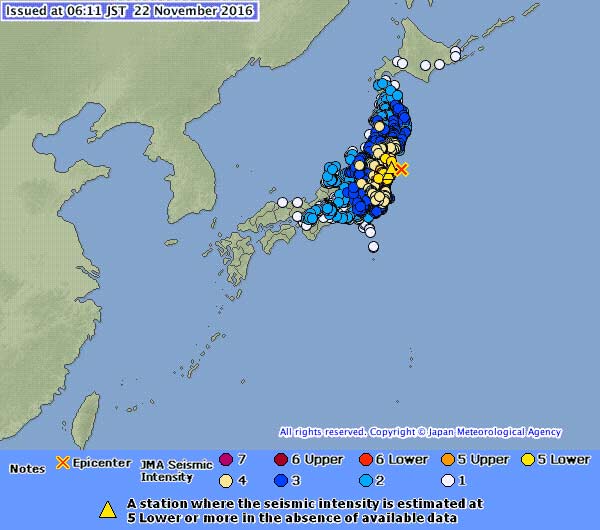At 5.59 a.m. local time on November 22, a powerful earthquake hit 37 km (23 miles) east-southeast of Namie in Japan's Fukushima Prefecture; strong tremors were felt as far away as Tokyo, 270 km (168 miles) to the south. A modest tsunami of 1.4 meters was observed in Sendai, and only a few minor injuries and limited damage were reported. The quake nevertheless made headlines around the world, principally because it struck near the Daiichi nuclear power plant damaged by the devastating M9.0 Tohoku quake and tsunami of 2011.
The Japan Meteorological Agency (JMA) originally reported the magnitude of the November 22 temblor as 7.3 and the depth as 30 km (18.6 miles); these have since been revised to M7.4 and 10 km (6 miles). The United States Geological Survey (USGS) also originally put the magnitude at 7.3, but later revised it to M6.9; USGS reports the depth as 11.4 km (7 miles). Why the differences?

Historically, there have been a number of ways to measure the strength of an earthquake—such as the Richter or local magnitude scale, the Mercalli scale, and the JMA scale, among others—all of which have their limitations. At AIR we use the moment magnitude scale, which is based on total moment release (moment is a product of the average distance a fault moved and the force required to move it). This scale is widely accepted today because it is based on earthquake average displacement, the rupture area, and the strength of the rocks in the vicinity of the rupture area.
When an earthquake occurs, vibrations called seismic waves travel through the ground away from the epicenter. To magnify and record true ground motion, scientists use readings from sensitive instruments called seismographs. Data from multiple instruments provide the relative arrival times and intensity of seismic waves used to calculate the location of earthquakes and quantify their magnitudes.
There are various types of seismic waves, the most important being the P-wave (a compressional wave) and the S-wave (a shear wave). S-waves are slower and larger than P-waves and cause most damage on the surface. The type and amplitude of the seismic waves that reach an instrument and are recorded depend on earthquake magnitude, the radiation pattern of the seismic waves due to different rupture mechanisms, and the complex geological structures along the propagation path of the seismic waves between the source and seismic stations.
The design of the instruments employed, their location in relation to the event, the nature of the event, and the various methods used to measure and describe the strength of an earthquake can result in differing figures being announced for the same quake. Furthermore, although scientists try to be as fast and as accurate as possible, they are generally working with massive amounts of data and often revise their initial figures soon after they have been released as a result of further analysis.
JMA magnitude is determined from the maximum ground displacement at different recording stations from multiple types of waves. As such it can be sensitive to local phenomena that impact the maximum displacement estimates. Moment magnitude, however, is more representative of the average displacement over the rupture area and less sensitive to local effects.
Earthquakes are complex events that happen invisibly and inaccessibly deep within the earth's crust. There are many approaches to measuring them and expressing their power, which produce pretty crude metrics in relation to the complexity of the events that they aim to describe; earthquake measurements are general estimates, not precise figures. It is not uncommon for different agencies to issue different magnitude and depth estimates for the same event. To remain consistent, AIR defers to figures issued by the USGS whenever possible.



